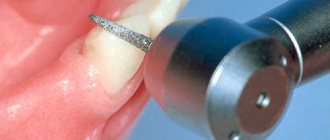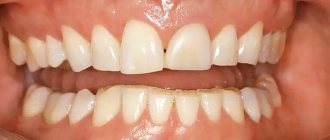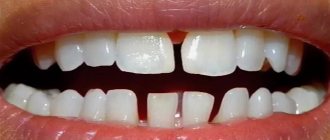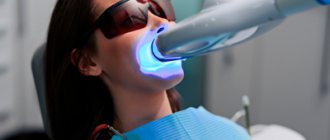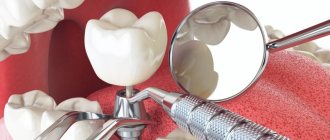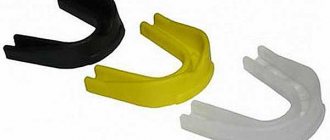Metal and plastic
These are inexpensive crowns that have been placed on the front teeth for decades.
The metal base was covered with an inert synthetic. But time has shown the conventional aesthetics of the structures - over time, the coating darkened and the metal became visible. After a couple of years, a painful replacement of the prosthesis was required. Today, metal-plastic crowns are cheap and can be used for the restoration of molars. But their aesthetic life is maximum 3 years. Therefore, this option is recommended as temporary. Before permanent prosthetics during implantation or in other cases when it is impossible to install a permanent prosthesis immediately after treatment.
Is it possible or not?
Combined type crowns are placed on any teeth. Most often on those located in the smile zone - frontal maxillary, upper premolars. If the client wishes, it is possible to cover the molars, but it will not be advisable to sharpen the supporting teeth too much.
It is recommended to install combined speakers in the following cases:
- destruction of more than 70% of the tooth volume;
- decreased height of the lower part of the face due to tooth wear;
- irreversible change in enamel shade;
- severe tooth mobility;
- complete or partial absence of teeth for various reasons;
- implantation;
- replacing old crowns;
- placing medications in the tooth;
- production of supports for special devices.
Zirconium dioxide and ceramics
Such dentures are flawless and are recommended for installation on the front teeth. The units are stronger than natural ones due to the stable zirconium frame, and the ceramic coating gives them a visual naturalness, ensuring correct light reflection.
But such a tooth crown is expensive. And it’s not always justified. Modern solid ceramics are close in strength to natural enamel. Therefore, in most cases, frameless ceramics, which are indistinguishable from natural units, are chosen for the restoration of the beauty area.
In addition, Cerec porcelain crowns for front teeth can be made within 1.5 hours; the price of this option is more affordable and its aesthetics are high. The artificial units created using innovative equipment will be flawless, you don’t need to get used to them - their parameters are calculated by a computer program taking into account the anatomical characteristics of a particular patient.
Indications and contraindications
Installation of combined products is indicated in the following cases:
- the crown part of the tooth is severely damaged and cannot be restored by other methods (approximately two-thirds of the tissue must be removed);
- increased abrasion, the lower third of the face is characterized by a decrease in height, that is, the normal contours are distorted;
- the color of the enamel has been changed, the process is irreversible and other restoration options will not be effective;
- mobility of individual units of the row is observed (such crowns are used as splinting, strengthening devices);
- partial edentia, in which the use of bridge structures is recommended;
- for implantation;
- as a reliable support for fixing orthodontic appliances;
- when replacing old dentures that are damaged or worn out.
Combined products are not installed in the following situations:
- the wall of a natural tooth is thinned, weakened and will not withstand additional load;
- risks of serious pulp damage during turning;
- the need to restore lower anterior teeth;
- deep bite, accompanied by protrusion of the upper incisors;
- age restrictions (such systems are not used until 16-18 years old);
- bruxism.
Metal ceramics
If it is necessary to replace molars, ceramics will not be suitable; the material is too fragile and will not withstand the increased load. Therefore, it is more reasonable to install metal-ceramic or zirconium crowns on chewing teeth. The last segment is more expensive. Therefore, many patients choose a metal cast crown coated with ceramics.
Modern frames are made only by casting. This ensures a tight fit of the crown in the remains of the natural tooth, preventing the entry of pathogenic microflora into the tooth.
When are combined crowns installed?
Metal-ceramics can be installed if a large tooth crown is destroyed; the frame will protect the remains of the molars from excessive loads.
Metal ceramics are installed:
- For a real tooth with a healthy, strong root that has crumbled by 50% or more.
- As part of the bridge structure - crowns on the supporting teeth.
- As a final prosthesis on implants.
The option is quite worthy for maintaining the function of chewing teeth and helping to preserve the structure of periodontal tissues.
But in general, if a tooth is more than 50 percent damaged, it is more advisable to install a Cerec module, and the tooth restored in this way will serve you for many more years.
Preparing teeth for crowns – should I be afraid of it?
Some patients become fearful after receiving information from a doctor that they must undergo a procedure such as tooth preparation before installing crowns. This happens because many people have no idea what it is? In practice, dissection acts as an important preparatory step and should not cause negative emotions at all.
Why is preparation necessary?
Due to the fact that the manufacture of crowns can be made from completely different materials, this feature should be taken into account at the preparatory stage of the teeth for the installation of dentures. Many patients are interested in the question: what is special about this procedure?
At the time of its implementation, the teeth are ground, thanks to which a special place is formed for installing crowns. Preparation is the first step towards starting prosthetics. But this process has some differences that are directly dependent on the type of crown being installed.
Subtleties of tooth preparation, based on the type of crown
• Installation of a one-piece crown involves grinding the tooth in a circle to the level of the tooth neck. The height of the fabric is removed to a thickness of approximately 1.5 mm. This procedure makes it possible to protect nearby teeth from damage.
• To install a metal-ceramic crown, the doctor must remove up to 2 mm of dentin and tooth enamel from all sides. This procedure is performed in order to give the stump the appearance of a truncated cone. In addition, you will need to make a special ledge in the place where the tooth turning area begins. As a result of such manipulations, a reliable fit of the fixed crown to the tooth surface is ensured. In order for the prosthesis to be secured as firmly as possible, the surfaces of the stump should have a slight roughness.
• Before installing a temporary crown, you will need to form a special rounded ledge, which will sink into the gum tissue about 0.1 mm. The stump will have to have a cone-shaped or cylindrical shape.
How to make a quality tooth preparation
Specialists of the Center for Dentistry of Innovative Technologies named after. Tikhonov, before starting prosthetics, all the required procedures are carried out. Their list includes not only tooth preparation for crowns, but also complete sanitation of the oral cavity, including professional hygiene. High-quality patient care here becomes possible thanks to the use of vast practical experience, a personal approach to patients, and the use of the latest modern equipment.
Advantages
Due to the metal base, combined crowns are stronger than real teeth. With proper care, their service life is 15 years
.
Additional advantages:
- They do not lose their shape or shade.
- Visually close to natural enamel. Therefore, they are invisible against the background of neighboring molars when laughing or talking.
- Reliable protection and functionality - you can safely chew your usual food.
- The risk of allergies is minimal (traditionally, up to 2% of people are sensitive to alloys).
When installed correctly, it adheres to the gum and tooth, protecting the units
Disadvantages of porcelain crowns
· High cost of construction. It is due to the complexity of technical work, which requires very high professionalism from a specialist.
· Relative fragility of the material. Patients have to avoid eating solid foods.
· Restrictions on indications. Porcelain crowns are not placed on all teeth.
· Manufacturing of single crowns only. Porcelain is not suitable for creating and installing bridges.
Manufacturing and installation of combined crowns
To put a metal-ceramic crown on your teeth (cost – 17,900 rubles / tooth), it will take 7-14 days
.
Manufacturing sequence:
- The tooth is prepared to the thickness of the crown.
- An impression is taken from which a cast crown is made.
- It is advisable to install temporary plastic protection on treated teeth.
- A metal frame is made and tried on.
- If adjustments are needed, they are made, and another fitting follows. When the artificial tooth fits, the metal is coated with ceramic.
- During installation, the tooth is covered with a protective compound, and the prosthesis is fixed with dental cement.
A nuance: the ceramics are applied in layers, each layer is baked in an oven under high temperature. Therefore, the coating is stable and securely attached to the metal base. Contact me at the dentist and we will decide what crown to put on the tooth in your case.
Important points to remember:
1) You should not get solid metal crowns if you have a metal allergy. To be sure, you can test your body's sensitivity to metals. It is very important that the cobalt-chromium alloy from which your artificial crowns or bridges will be made does not contain beryllium or nickel. These additives significantly increase the risk of developing allergies and inflammation of the gums around the crowns.
2) If you already have metal crowns on your teeth (including metal-ceramic), this could be a potential problem. The fact is that the presence of different metal alloys in the oral cavity will definitely lead to the development of electrochemical reactions, i.e. galvanosis will develop. The latter may be characterized by a constant unpleasant metallic taste in the mouth, burning, and the development of diseases of the oral mucosa.
Therefore, only one version of the cobalt-chromium alloy should be used in one patient for prosthetics with solid-cast and metal-ceramic crowns. But even in this case, the risk of developing galvanosis will be present, although it will be significantly lower. Therefore, if you already have metal-ceramics or cast crowns, it is safer to make ceramic crowns from pressed ceramics or zirconium dioxide. We hope that our article on the topic: Reviews of solid crowns was useful to you!
Sources:
1. Personal experience as a dentist, 2. “Orthopedic dentistry. Textbook" (Trezubov V.N.), 3. National Library of Medicine (USA), 4. https://www.realself.com/, 5. "Crowns and bridges in orthopedic dentistry" (Smith B.).

